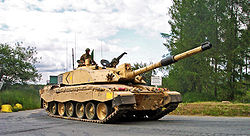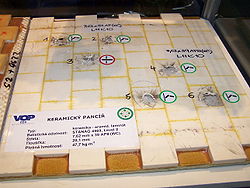- Composite armour
-
 Plasan Sand Cat light (5t) military vehicle featuring integrated composite armoured body
Plasan Sand Cat light (5t) military vehicle featuring integrated composite armoured body
 SICADUR silicon carbide tiles for vehicles
SICADUR silicon carbide tiles for vehicles
Composite armour is a type of vehicle armour consisting of layers of different material such as metals, plastics, ceramics or air. Most composite armour are lighter than their all-metal equivalent, but instead occupy a larger volume for the same resistance to penetration. It is possible to design composite armour stronger, lighter and less voluminous than traditional armour, but the cost is often prohibitively high, restricting its use to especially vulnerable parts of a vehicle. Its primary purpose is to help defeat high explosive anti-tank (HEAT) rounds.
HEAT had posed a serious threat to armoured vehicles since its introduction in World War II. Lightweight and small, HEAT rounds could nevertheless penetrate hundreds of millimetres of the hardest steel armours. The capability of most materials for defeating HEAT follows the "density law", which states that the penetration of shaped charge jets is proportional to the square root of the shaped charge liner density (typically copper) divided by the square root of the target density. On a weight basis, lighter targets are more advantageous than heavier targets, but using large quantities of lightweight materials has obvious disadvantages in terms of mechanical layout. Certain materials have a sweet spot in terms of density that makes them particularly useful in this role.[1]
Contents
History
The earliest known composite armour for armoured vehicles was developed as part of the US Army's T95 experimental series from the mid-1950s. The T95 featured "siliceous-cored armor" which contained a plate of fused silica glass between rolled steel plates. The stopping power of glass exceeds that of armour steel on a thickness basis and in many cases glass is more than twice as good as steel on a thickness basis. Although the T95 never entered production, a number of its concepts were used on the M60 Patton, and during the development stage (as the XM60) the siliceous-cored armour was at least considered for use, although it was not a feature of the production vehicles.[1]
The first widespread use of a composite armour appears to have been on the Soviet T-64. It used an armour known as Combination K, which apparently is glass-reinforced plastic sandwiched between inner and outer steel layers. Through a mechanism called thixotropy, the resin changes to a fluid under constant pressure, allowing the armour to be moulded into curved shapes. Later models of the T-64, along with newer designs, used a boron carbide-filled resin aggregate for greatly improved protection. However the quality of the tanks produced during this era varied widely; if the boron carbide was not available in time to meet production quotas, the tank would be shipped with any filler that could be found, and sometimes nothing at all. In order to deal with these problems, the Soviets invested heavily in reactive armour, which allowed them some ability to control quality, even after production.
The most common type of composite armour today is Chobham armour, first developed and used by the British in the experimental FV 4211 tank, which was based on Chieftain tank components. Chobham sandwiches a layer of ceramic between two plates of steel armour, which was shown to dramatically increase the resistance to HEAT rounds, even in comparison to other composite armour designs. Chobham was such an improvement that it was soon used on the new U.S. M1 Abrams main battle tank (MBT) as well. It is the fabrication of the ceramic in large tiles that gives the Challenger and Abrams their "slab sided" look.
Design
Chobham's precise mechanism for defeating HEAT was uncovered in the 1980s. High speed photography showed that the ceramic material shatters as the HEAT round penetrates, the highly energetic fragments destroying the geometry of the metal jet generated by the hollow shaped charge, greatly diminishing the penetration. The effectiveness of the system was amply demonstrated in Desert Storm, where not a single British Army Challenger tank was lost to enemy tank fire. However, one was destroyed by friendly fire on March 25, 2003 killing two crew members after a HESH round detonated on the commander's hatch causing high velocity fragments to enter the turret.[2] Chobham-type armour is currently in its third generation and is used on modern western tanks such as the British Challenger 2 and the American M1 Abrams.
Usage
The French Leclerc, Indian Arjun MBT, Japanese Type 90 tank, Pakistan's Al-Khalid[3] tank and Chinese Type 96/98 and Type 99 tanks use modular composite armour. The adoption of Modular composite armour design facilitated upgrading and exchange of the armour.
Soviet/Russian T-80Us and Pakistan Al-Khalid use composite armour in tandem with the explosive reactive armour (ERA), making it hard for missiles and tank rounds to penetrate the frontal and a portion of their side armour.
Composite armour has since been applied to smaller vehicles, right down to jeep-sized. Many of these systems are applied as upgrades to existing armour, which makes them difficult to place around the entire vehicle. Nevertheless they are often surprisingly effective; ceramic upgrades to Canadian M-113s were carried out in the 1990s, after it was realized that it would offer more protection than newly built APCs like the M2 Bradley.[citation needed]
Improvised
In 2004, Marvin Heemeyer used an ad-hoc composite armour on his Komatsu D355A bulldozer ("Killdozer") used in a rampage in response to a dispute with the city he lived in over a zoning issue. The armour, at some places a foot thick, consisted of a layer of concrete sandwiched between layers of steel, successfully rendering the vehicle impervious against small arms fire.
See also
- AMAP
- Chobham armour
- Combination K
- Kanchan armour
- MEXAS
References
- ^ a b Evaluation of Siliceous Cored Armor for the XM60 Tank
- ^ "UK Ministry of Defence : Army Board of Inquiry Report" (PDF). http://www.mod.uk/NR/rdonlyres/C2384518-7EBA-4CFF-B127-E87871E41B51/0/boi_challenger2_25mar03.pdf. Retrieved 2011-07-02.
- ^ Link Globalsecurity.org--Al Khalid MBT-2000 / Type 2000 Main Battle Tank
Categories:- Vehicle armour
- Composite materials
Wikimedia Foundation. 2010.



